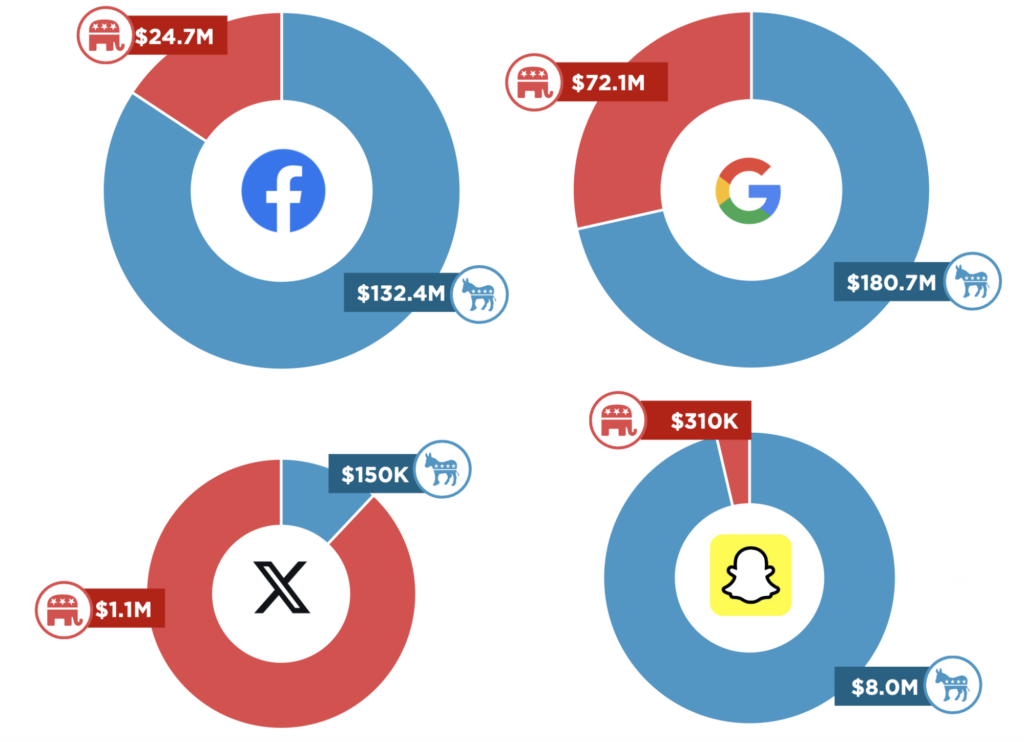The 2024 presidential election offered a fascinating study in contrasting campaign strategies. Despite Vice President Kamala Harris outspending President-elect Donald Trump on advertising by $460 million, Trump secured victory.
According to existing FEC filings, Harris allocated $346 million to radio, TV, and digital ads, while Trump spent $147 million. However, ad-tracking firm AdImpact reports that true ad spend will be even higher, with Harris allocating an additional $647 million and Trump $273 million by Election Day. Total combined spend is projected to be in the range of $11 billion – the most spent to date in a U.S. election.
Despite the difference in advertising spend, Trump’s targeted guerrilla marketing tactics helped secure his victory, demonstrating how marketing can shape our perceptions and the misconception that higher spending is required to be effective.
Swing States and Targeted Tactics
Both campaigns focused on swing states Georgia, Michigan, Pennsylvania, North Carolina, Arizona, Nevada, and Wisconsin. Harris opted for blanket coverage, while Trump’s team took a more localized approach. Trump’s campaign dismissed Harris’ strategy as “overinvestment,” but in a race for the nation’s highest office, is overinvestment possible?
A Trump campaign representative argued, “Ads supporting President Trump reach more people than Harris ads. Her campaign scatters funds carelessly because they have no idea how to run a winning campaign.” Trump’s team applied lessons from 2016, using targeted segmentation and emotionally resonant messages. Harris’ broad messaging mirrored Hillary Clinton’s unsuccessful 2016 strategy.
The following illustration taken from AdImpact, represents broadcasts within each battleground state and the key messages each candidate focused on:

The Rise of CTV and OTT
CTV and OTT platforms offered immense reach, accessing over 150 million households, including younger demographics. Harris secured ad spots during major sporting events and prime-time shows.
Trump focused on YouTube, Hulu, Spotify, Roku, Paramount, and Pandora. Success hinged on simple messaging and targeted reach. Programmatic advertising enabled deep geo-fencing, surpassing Google’s location targeting. Trump leveraged this to tailor messages to specific populations.

Platform Choices and Emerging Opportunities
Kamala Harris focused the bulk of her advertising budget on Google, Facebook, and Instagram, while the Trump campaign concentrated its presidential election ad spending on YouTube and Twitch. Meta’s political targeting limitations played a part in Trump’s decision to allot less ad dollars across their platforms.
Gen Z was a key audience in this year’s election. Trump reached Gen Z voters who don’t follow traditional politics by streaming his rallies on Twitch. This strategy, though criticized by some, demonstrated adaptability in using emerging digital platforms. Harris’s campaign revolved around reaching younger voters via SnapChat and TikTok instead.
Here’s a breakdown of the platforms favored by each candidate:

The Power of Podcasting and Influencers
As audiences hungered for authentic content, podcasting emerged as a powerful tool for making each candidate relatable, connecting with voters on a deeper level than conventional politics allowed.
Trump’s three-hour interview on The Joe Rogan Experience showcased his conversational style. Harris appeared on Call Her Daddy. Trump’s campaign also partnered with social media influencers to engage younger voters. By collaborating with popular streamers, they generated excitement beyond traditional outreach.
Building on this strategy, Trump’s campaign made a bold move by teaming up with social media influencers like Logan Paul and Adin Ross to resonate with younger, frequently apathetic voters. Through guest appearances on well-known streams and partnerships with online personalities, the campaign aimed to energize typically disengaged young voters and stir enthusiasm that transcended typical political engagement tactics.
The Shifting Landscape
The 2024 presidential election offered an intriguing case study, highlighting that success isn’t solely about the amount spent on advertising, but rather the strategic placement and approach. Leveraging streaming platforms and employing more localized targeting can forge deeper connections with key demographics, making this a victorious strategy in the contemporary digital landscape. This underscores the vital importance of gaining insight into your audience and engaging them on their preferred platforms, rather than merely relying on broad, blanket advertising. The landscape is evolving, and those who adapt their tactics will be the ones to reap the benefits.




